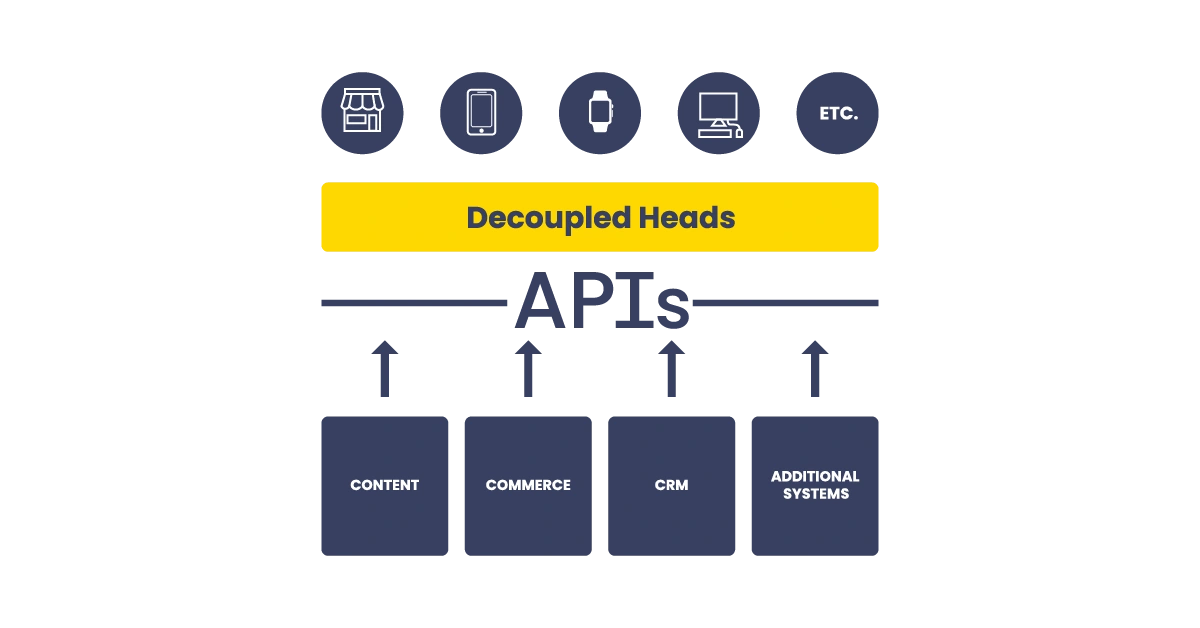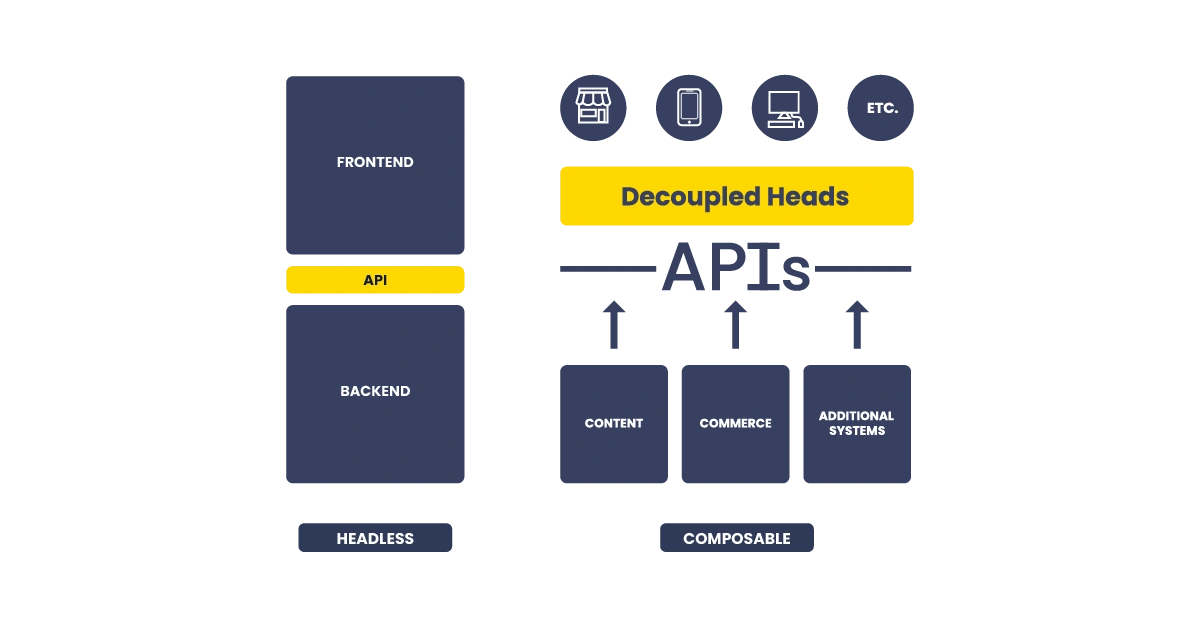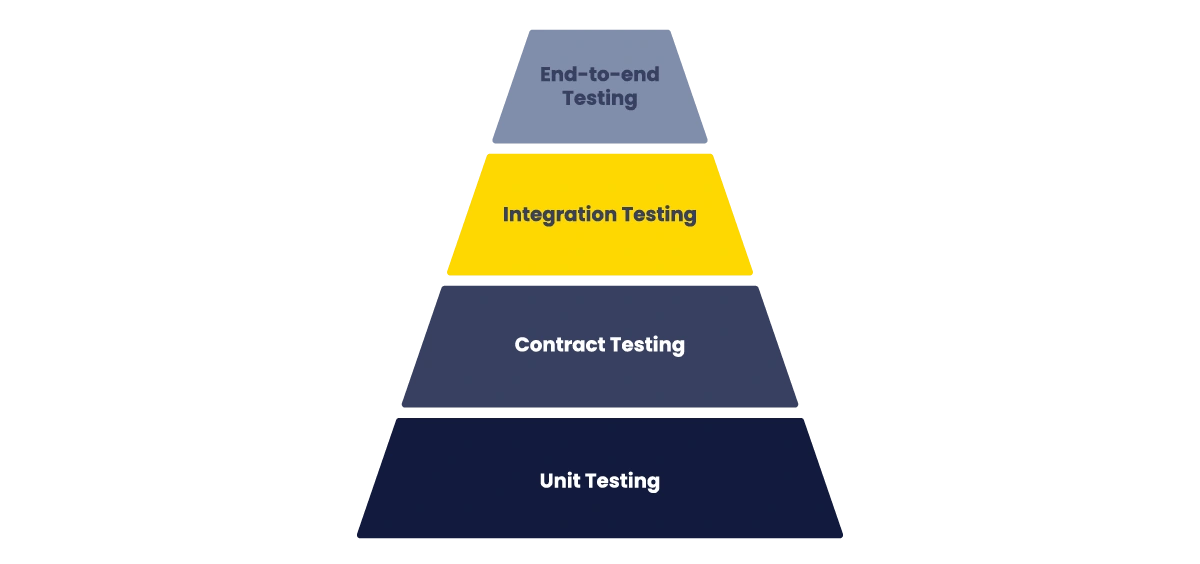- What is composable architecture?
- Advantages of flexibility, scalability, and maintainability
- Composable architecture: Key principles and components
- Design patterns and dependency management in composable architecture
- Testing and debugging in composable architectures
- Real-world use cases and composable architecture success stories
- Considerations for implementing a composable architecture
- Final thoughts
- Composable Architecture FAQs

GSD
Composable Architecture Explained: What Is It & How Can It Boost Scalability and Efficiency?
Posted by Maab Saleem on March 27, 2024
Businesses need to be agile and adaptable to keep up with modern consumer expectations and the ever-changing market dynamics. They must be capable of delivering new features and experiences quickly across all customer channels.
However, traditional monolithic architectures, where everything is coupled in one giant codebase, can become a bottleneck for innovation. Changes take time, entire systems need to be tested and deployed, and updates can be disruptive. This is why forward-thinking businesses are turning to composable architectures.
In this piece, we will cover everything you need to know about composable architectures, including their advantages, core principles, implementation considerations, and success stories.
Table of contents
What is composable architecture?
Composable architecture is a design approach that emphasizes modularity, reusability, flexibility, and interoperability. It breaks down complicated, spaghetti-code systems into smaller, self-contained components, such as microservices, headless apps, or Product-Based Components (PBCs).
These components can be independently built, tested, and deployed, which promotes faster development cycles and reduces the risk of introducing bugs or breaking changes in the system. They can also be assembled in different configurations at any given time (much like Lego blocks) to address specific use cases without requiring extensive rework of the entire system.
These features make “going composable” a no-brainer for many modern businesses. Take Role Model Software, for example. Their traditional CMS hindered rapid content updates and design changes, so they decided to go composable with a headless CMS to optimize their content management workflows.
This transition allowed the company to reduce publishing times from a week to near instantaneous. Moreover, their marketing team gained the freedom to modify their website as and when needed, without developer assistance.
Advantages of flexibility, scalability, and maintainability
Composable architectures offer a plethora of tangible advantages to businesses. Here are some:
Easy adoption to changing requirements
A composable software foundation enables a company to meet the challenges of the ever-evolving digital scene head-on. Independent, modular components make it possible to:
-
Add and integrate new features quickly without rewriting existing code.
-
Swap out or modify a component without disrupting overall system functionality.
-
Test new features on a smaller scale, minimizing risk and time to market.
Modular and reusable components make development easier
Developers are often the biggest fans of composable architectures. The modular approach allows them to:
-
Leverage pre-built components to put together MVPs much faster.
-
Avoid reinventing the wheel and focus on adding unique value.
-
Recompose existing components to adapt to changing consumer demands.
-
Promote clean and maintainable code practices through modular design and clear component boundaries.
Facilitate growth with independent scalability
As businesses grow, their software needs evolve. Composable architectures shine in these situations:
-
They are scalable by design. Individual components can be scaled up or down based on their specific load using techniques like serverless functions.
-
They are typically API-first, which allows seamless integration with leading technology providers and keeps you at the forefront of innovation.
-
They are future-proof. You can swap out components for more powerful solutions to accommodate rising demands.
Enhanced system reliability and fault-tolerance
Infrastructures built on the principles of composable design are more reliable and fault-tolerant because:
-
Isolated components reduce the likelihood of issues propagating throughout the system.
-
Faults in one component are less likely to impact the overall system, enhancing fault tolerance.
-
Clear component boundaries make it easier to identify and resolve faults.
Composable architecture: Key principles and components
Before you start implementing a composable architecture for your enterprise, it’s important to understand its key principles and components. We’ll be explaining them in the next few sections.
Modular design and loose coupling
A truly composable architecture has loosely coupled modules, meaning each module exists as a separate, self-contained entity that communicates with other modules through well-defined interfaces, like APIs.
Self-contained modules facilitate easier development, testing, and maintenance. For example, consider Netflix’s microservices architecture. Netflix uses small, independently deployable services to manage user authentication, recommendation algorithms, content delivery, and other aspects. Each service operates as a self-contained module, allowing teams to develop, test, and deploy changes without being encumbered by unrelated features.
The Importance of Minimizing Dependencies in Composable Architectures
The idea behind loose coupling is to reduce interdependencies between components and allow them to evolve independently. In such a system, components can be restarted, scaled, or modified with little to no effect on other parts of the system. For example, in an e-commerce platform, separating the inventory management module from the order processing module allows each team to work autonomously.
Airbnb’s service-oriented architecture is a real-world success story of loose coupling. In this architecture, loosely coupled microservices communicate via APIs, enabling seamless interaction while maintaining independence. This approach allows teams to deploy updates, like enhancing search relevance, without disturbing other facets of the platform.
Headless vs. composable
Headless and composable architectures both aim to enhance flexibility and scalability, but they represent different stages of architectural evolution:
A headless architecture decouples the frontend presentation layer (website, mobile app) from the backend layer (database, product information), allowing for independent development and deployment of frontend experiences.
A composable architecture builds upon the foundation of headless architecture by further decomposing the backend and frontend layers into independent, reusable modules, leading to even greater flexibility, scalability, and maintainability.
Reusability and scalability
Reusability is a cornerstone of composable architectures. The ability to reuse pre-built, well-tested components accelerates the product development process and promotes consistency and reliability across applications.
Reusability can deliver tangible benefits across industries. For example, in the e-commerce sector, you can have reusable modules for user authentication, cart management, and product search functionality. Similarly, there can be reusable modules for payment processing, fraud detection, and account management in the fintech industry.
Adding and removing modules on demand
Replaceability and interoperability are core tenets of composable design. Businesses can add new functionalities by introducing additional modules to their ecosystem. Similarly, they can remove older modules no longer needed, promoting scalability as systems can seamlessly be adapted to accommodate changing demands and technological advancements without undergoing major architectural overhauls.
Uber's composable API gateway is an excellent illustration of composable architecture's scalability in action. It allows the company to scale its ride-sharing platform globally.
Technologies enabling composable architecture
Next, let’s discuss the fundamental technologies upon which composable architectures are built:
Microservices and API-based integrations
Microservices are often the core building blocks of a composable architecture. Here are some of the characteristics that support composable setups:
-
Each microservice encapsulates a specific business function and can thus be developed, tested, and deployed as an independent module.
-
Microservices communicate via well-defined APIs, which promotes loose coupling and minimizes dependencies between components.
-
Each microservice typically has its own source code repository, which ensures that changes made to one microservice don’t affect others.
By defining clear contracts for communication, APIs ensure interoperability and extensibility in a microservices-based composable architecture. For example, a user authentication microservice may expose an API for user login and authorization, which is available for use by multiple microservices within the architecture.
Containerization and container orchestration
Containerization is an approach that encapsulates everything an application needs to function, including its source code and dependencies, into portable, self-contained units called containers.
Containers ensure that an application receives a consistent runtime environment, regardless of the platform on which it’s executed. They are a top choice for packaging, shipping, and deploying components of a composable architecture because:
-
Microservices running within containers are isolated from each other, preventing conflicts and increasing fault tolerance.
-
Containerized components can be easily deployed in different environments without modification.
-
Containers are much smaller than virtual machines, leading to faster deployment times and efficient resource utilization.
-
Individual containers can be scaled independently based on their resource needs.
However, managing a myriad of independent microservice containers can be challenging. This is why composable enterprises use orchestration tools like Kubernetes to automate the deployment, scaling, and management of containerized applications. Kubernetes, an open-source platform, ensures containers are always running at the desired scale and meeting resource requirements.
Design patterns and dependency management in composable architecture
To get your composable architecture right, it’s important to adhere to certain design patterns and best practices regarding dependency management.
Design patterns for modularity and reusability
A design pattern is a set of guidelines that helps solve common software design problems. Here are a few design patterns commonly used for composable architectures:
-
Facade pattern: Simplifies interactions with complex systems by providing a single interface to a collection of underlying components
-
Repository pattern: Encapsulates data access logic, promoting code reuse and easier integration with different data storage solutions
-
Factory pattern: Enables the creation of objects without specifying their concrete classes, promoting flexibility and decoupling
-
Observer pattern: Facilitates event-driven communication between components by defining a one-to-many dependency between objects
By following these established patterns, developers can design modular systems that are easier to maintain, reuse, extend, and adapt. For example, Netflix uses the Observer and Observable patterns for its highly scalable APIs. Similarly, AWS uses the builder pattern in its SDKs to make it easier to work with immutable objects.
Best practices for designing modular and reusable components
Next, let’s explore a few best practices to help you make modularity and reusability fundamental aspects of your composable architecture.
-
Follow the single responsibility principle, which dictates that each component should have a clear and well-defined responsibility.
-
Aim to keep components highly cohesive, meaning each module should contain closely related functionality. At the same time, minimize dependencies between modules to reduce the risk of cascading changes.
-
Anticipate future changes and requirements by designing components that are extensible by design. For example, design components with extension points or hooks for easy customization.
-
Document the architecture, design patterns, and interfaces used in your composable system to ensure clarity among all relevant stakeholders.
-
Prioritize straightforward solutions over complex ones to ensure that components are easier to understand, maintain, and reuse.
Managing dependencies in composable systems
Some level of dependency between loosely coupled components is inevitable. Here are some techniques to minimize dependencies, manage them effectively, and promote loose coupling:
-
Avoid unnecessary dependencies between components, as they can lead to tight coupling. Tightly coupled systems are difficult to change and maintain. As a golden rule, before creating a dependency, carefully consider whether it’s essential for the functionality of the component.
-
Use dependency inversion principles to manage dependencies. Instead of relying on concrete implementations, depend on abstractions or interfaces. This allows modules to be replaced without affecting other parts of the system.
-
Prefer event-based communication over synchronous interactions between components. Event-based communication allows components to communicate asynchronously, reducing direct dependencies and promoting loose coupling.
-
For example, consider an event-driven, composable e-commerce system. The shopping cart module publishes an "Item Added" event with product details. The product information component, subscribed to this event, then updates its inventory data without needing to know directly about it or depend on the shopping cart module.
-
-
Use versioning tools to manage dependencies between components to prevent unexpected issues when components are updated.
Testing and debugging in composable architectures
Testing and debugging composable systems requires a comprehensive approach that accounts for the modular nature of the architecture.
Approaches for testing composable systems
Here are some approaches that your developers and QA engineers can use to test the functionality and resilience of your composable architecture:
Unit testing
Unit testing is the foundation of any testing strategy. It focuses on validating individual components in isolation, ensuring each component functions as expected before integration.
Integration testing
Integration testing verifies how components interact with each other. It is crucial for identifying compatibility issues and ensuring a smooth flow of data.
Contract testing
Contract testing validates that components adhere to their API contracts. It guarantees consistent behavior and prevents unexpected integration failures.
End-to-end testing
End-to-end tests check whether all components are working together as expected to achieve the desired outcomes.
Testing guidelines for composable architectures
Rigorous testing of composable architectures is crucial to ensure early fault detection, functional stability, and reliability. Here are a few best practices to follow:
-
Automate testing to streamline the testing process, ensure consistent coverage, and catch bugs early.
-
Integrate testing into your CI/CD pipelines to ensure that bugs and unintended changes never make it to production.
-
Use mocks and stubs to simulate dependencies during unit testing. This enables efficient testing of individual components in isolation.
-
Parameterize tests to cover a wide range of input scenarios and edge cases. This will help identify potential vulnerabilities and edge case failures that may arise in larger composable architectures.
Debugging challenges and solutions
Debugging in a composable setup can pose unique challenges due to the distributed and modular nature of the system. Here are a few common pitfalls:
-
It can be difficult to trace the data flow and control across multiple interconnected modules.
-
Identifying and isolating issues caused by dependencies can be challenging.
-
Debugging asynchronous communication and event-driven workflows can be challenging, especially if you don’t have centralized logging.
-
Finding the root cause of a system-wide bottleneck or outage can be problematic, particularly if you don’t have a robust monitoring system.
Debugging strategies for composable systems
To avoid and overcome the aforementioned challenges, leverage these strategies:
-
Correlate logs and trace requests across distributed components using structured logging formats and distributed tracing tools (like Zipkin). Moreover, consider implementing centralized logging through tools like Logstash.
-
Expose diagnostic endpoints or health checks in each module to provide visibility into its internal state and health.
-
Use techniques like fault injection and chaos engineering to identify weaknesses and vulnerabilities in the system proactively.
-
Use remote debugging tools to troubleshoot distributed components running in different environments or containers.
Real-world use cases and composable architecture success stories
Composable architectures have helped several organizations address real-world challenges. Let's look at a couple of examples.
With over half a billion active users globally, Spotify uses a composable architecture to ensure a seamless music streaming experience. This approach combines APIs, components, and resources to scale and adapt the platform to meet its users' diverse needs.
Freddie's Flowers is a fresh flowers subscription service from England. As they planned to expand out of the UK, they realized a need to ditch their legacy stack for a more scalable option. Opting for the composable approach, they leveraged ButterCMS, a headless CMS, to build a composable content stack. By decoupling the presentation layer from the backend, they empowered their marketers to create dynamic landing pages at scale without developer assistance.
Considerations for implementing a composable architecture
Before diving into composable architecture, take the following considerations into account:
-
Establish clear evaluation criteria to determine the suitability of a composable architecture. Consider factors like system complexity, agility expectations, and the need for independent scaling. For example, composable may not be a good fit if your project is a simple, well-defined application with limited future growth projections.
-
Anticipate and prepare for potential challenges you may face during and after implementation. These can include security issues, dependency management problems, and stakeholders' resistance to change.
-
Composable architecture requires a skill set different from that of monolithic development. Assess your team's capabilities and consider training or hiring developers with relevant experience.
-
Understand the impact of composable on existing systems. Consider aspects like integration with legacy systems, data migration requirements, and potential workflow disruptions.
-
Develop a well-defined migration strategy for a smooth transition. Incremental adoption, phased implementation, and prioritization of high-impact areas can help mitigate risks.
Final thoughts
Composable architecture offers organizations a flexible approach to building and adapting software applications. However, to harness its maximum potential regarding scalability and efficiency, it is vital to learn its principles, components, testing strategies, and best practices.
Composable Architecture FAQs
How does composable architecture enable flexibility and maintainability?
Composable architectures are built using loosely coupled microservices, which are inherently easier to maintain, adapt, and scale than monoliths.
What is the difference between microservices and composable architecture?
Microservices are a core building block of composable architectures. Each microservice handles a specific business function in a composable setup.
How are PBCs (packages business capabilities) related to composable architecture?
PBCs are modularized business functionalities that can be independently developed, deployed, and integrated in a composable architecture.
What is the difference between headless and composable architecture?
A headless architecture separates the frontend of a website/app from its backend. A composable architecture further breaks down the frontend and backend layers into smaller modules.
How is composable suited for ecommerce?
In a composable ecommerce application, core functionalities are distributed across self-contained modules, such as product catalog management, authentication, order fulfillment, and layout. This modular nature enhances the ecommerce app's customizability, agility, and scalability.
ButterCMS is the #1 rated Headless CMS
Related articles
Don’t miss a single post
Get our latest articles, stay updated!






















Maab is an experienced software engineer who specializes in explaining technical topics to a wider audience.